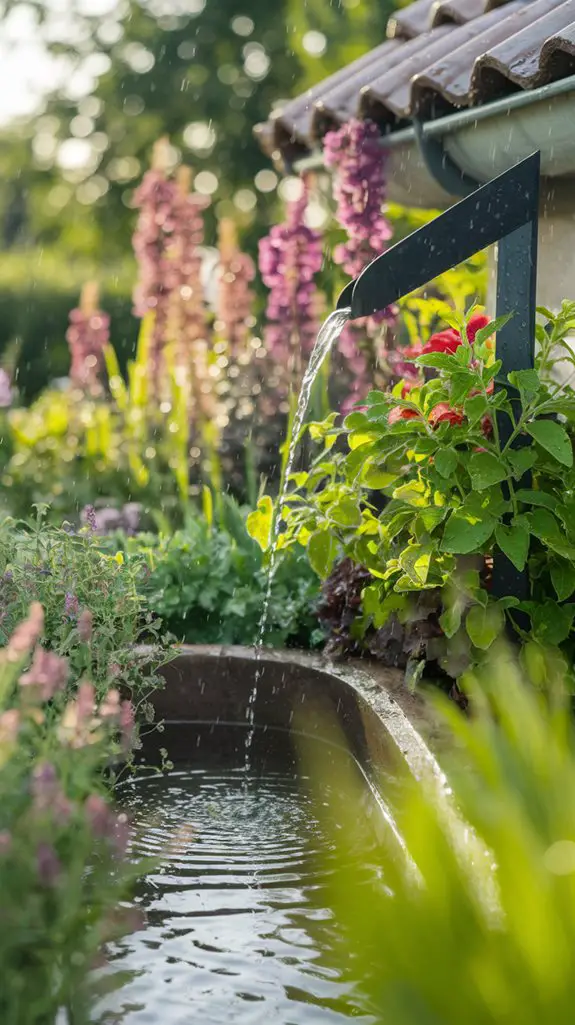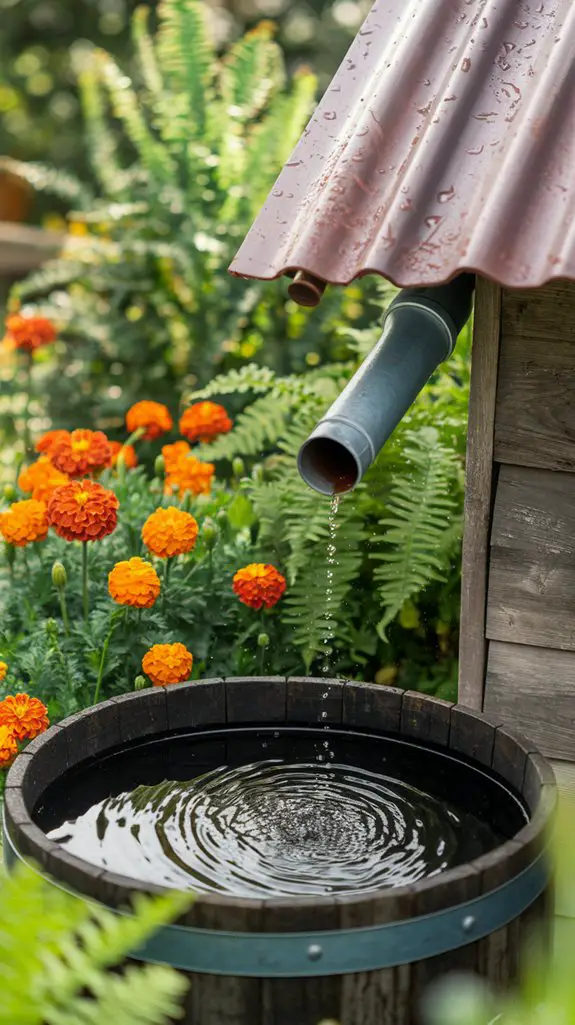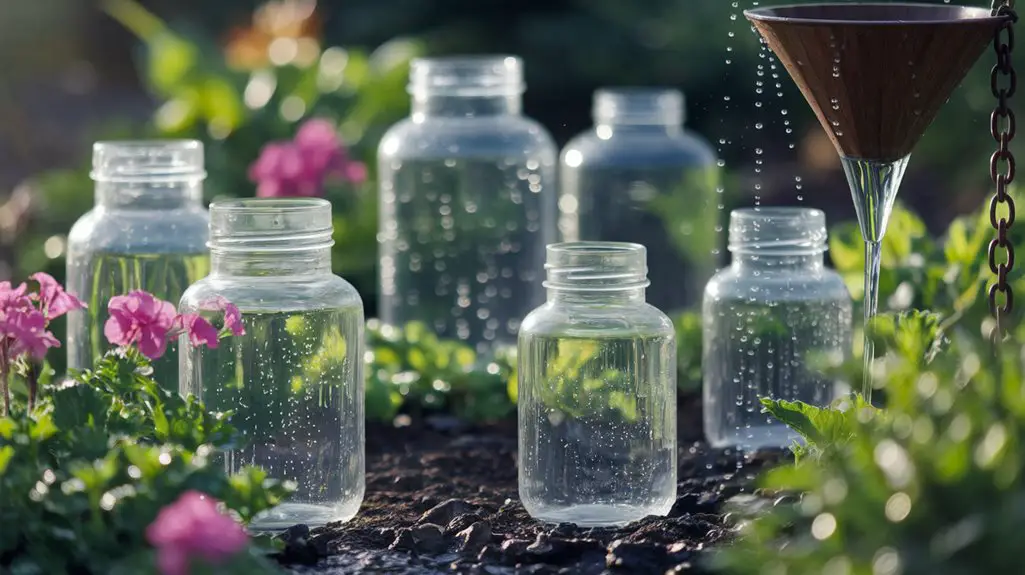Just as every raindrop contributes to a vast ocean, each gallon of rainwater you collect adds to significant garden benefits. You’ll cut water bills while nourishing your plants with nature’s purest irrigation source—free from chlorine and harsh minerals found in tap water. Your garden thrives with soft rainwater that improves nutrient absorption, while you’re simultaneously reducing stormwater runoff and building drought resilience. The rewards of rainwater harvesting extend far beyond simple conservation.
Economic Benefits of Harvesting Rainwater
When you collect rainwater for your garden, you’ll quickly notice significant savings on your water bill. A typical household can collect thousands of gallons annually, reducing utility costs by 30-50% during growing seasons. This free resource eliminates the need for expensive filtration systems required for tap water.
Beyond immediate savings, rainwater harvesting extends the life of your irrigation equipment. Lacking chlorine and harsh minerals, rainwater prevents scale buildup and corrosion in pumps and sprinklers. You’ll replace these components less frequently, avoiding costly repairs.
Additionally, many municipalities offer financial incentives for rainwater collection systems. Tax credits, rebates, and reduced stormwater management fees can offset initial setup costs. Some jurisdictions even provide free rain barrels to encourage conservation practices, maximizing your return on investment. Implementing a rainwater system also contributes to drought resilience, helping to mitigate the effects of water scarcity during dry periods.
Environmental Advantages for Sustainable Gardens

Beyond the financial benefits, rainwater harvesting creates significant environmental advantages for your garden ecosystem. By capturing precipitation directly, you’re reducing runoff that would otherwise carry pollutants into local waterways and overtax municipal systems during heavy storms.
- Natural pH Balance – Unlike treated tap water, rainwater’s slightly acidic nature helps your plants absorb nutrients more effectively, resulting in visibly healthier, more vibrant growth.
- Reduced Carbon Footprint – You’ll eliminate the energy costs associated with treating and pumping water to your home, directly lowering your garden’s environmental impact.
- Drought Resilience – Your garden will thrive even during water restrictions, providing a sanctuary for local wildlife when natural water sources become scarce. Additionally, implementing eco-friendly rainwater harvesting practices contributes to the overall sustainability of your landscape.
Simple DIY Collection Methods Anyone Can Implement

Setting up your own rainwater collection system doesn’t require specialized knowledge or expensive equipment. The simplest method involves placing rain barrels directly under downspouts, capturing water that would otherwise flow away.
Install a debris screen to prevent leaves and twigs from entering.
For larger gardens, consider linking multiple barrels with overflow connectors, creating a cascading system that maximizes storage capacity. Elevate barrels on cinder blocks to improve water pressure and allow gravity-fed distribution.
If you’re working with minimal space, collapsible rain bags offer a compact alternative. They can be hung from gutters and stored easily when not in use.
Remember to install a spigot near the bottom of any collection vessel for easy access when watering your plants. This placement utilizes natural pressure while emptying the entire container. Additionally, utilizing affordable rainwater harvesting solutions can further enhance your system’s efficiency.
Water Quality Benefits for Plant Health
Rainwater offers significant advantages over municipal tap water, particularly for the health of your garden plants.
Unlike treated city water, rainwater contains no chlorine, fluoride, or other chemicals that can accumulate in soil and stress sensitive species. It’s naturally soft, with optimal pH levels that enhance nutrient absorption.
- Natural Nitrogen Boost – Rainwater carries atmospheric nitrogen, providing your plants with free fertilizer that strengthens foliage and promotes vibrant growth.
- Ideal Temperature Match – Unlike cold tap water that can shock plant roots, rainwater arrives at ambient temperature, reducing transplant stress and encouraging healthy root development.
- Mineral Balance – The trace minerals in rainwater create perfect growing conditions that commercial fertilizers simply can’t replicate, resulting in tastier vegetables and more fragrant flowers. Additionally, harvesting rainwater can support sustainable outdoor water features, enhancing both your garden’s beauty and its ecological footprint.
Creating Drought Resilience in Your Garden
As climate patterns become increasingly unpredictable, establishing a drought-resilient garden offers critical protection against water scarcity and extreme weather events.
Your rainwater collection system serves as a first-line defense, providing irrigation when municipal restrictions limit water use. By capturing rainfall during wet seasons, you’ll build a reservoir that sustains plants through dry periods—potentially saving your garden when others wither.
This resilience doesn’t just maintain plant health; it preserves your investment in landscaping and food production. For optimal performance, consider selecting the right rainwater tank to ensure adequate storage capacity and efficiency.
For maximum drought protection, pair your rainwater system with complementary strategies: apply mulch to reduce evaporation, select native drought-tolerant plants, and implement efficient drip irrigation.
Together with your harvested rainwater, these approaches create a garden that withstands climate challenges while reducing dependence on increasingly stressed municipal water supplies.
Conclusion
Harvesting rainwater for your garden is like creating a personal reservoir of liquid gold for your plants. You’ll enjoy significant savings, healthier plants, and contribute to environmental conservation with minimal effort. By implementing simple collection systems, you’re ensuring drought resilience while providing chemical-free hydration. Start collecting rainwater today—your garden, wallet, and the planet will all reap the rewards of your sustainable choice.




